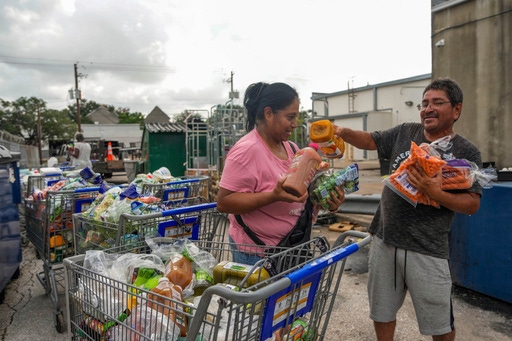Half a million Houston-area homes and businesses still won’t have power into next week

East End residents Laura and Jose Galvan sift through perishable foods that were left outside of a Kroger due to power outages from the recent Hurricane Beryl that made landfall in Houston on Tuesday, July 9, 2024. (Raquel Natalicchio/Houston Chronicle via AP)[ASSOCIATED PRESS/Raquel Natalicchio]
HOUSTON (AP) — About half a million Houston-area homes and businesses will still be without electricity next week, the city’s largest utility said Thursday, stoking the frustration of hot and weary residents and leading a top state official to call the pace of recovery from Hurricane Beryl “not acceptable.”
Jason Ryan, executive vice president of CenterPoint Energy, said power has been restored to more than 1 million homes and businesses since Beryl made landfall in Texas on Monday. And the company expects to get hundreds of thousands of more customers back online by Sunday. But many more will wait much longer.
“We know that we still have a lot of work to do,” Ryan said during a meeting of the Texas Public Utility Commission, the state’s utility regulation agency. “We will not stop the work until it is done.”
Ryan said that the prolonged outages into next week would be concentrated along the Gulf Coast, close to where Beryl came ashore.
During a news conference Thursday, Lt. Gov. Dan Patrick pushed CenterPoint to work faster to relieve residents who have been without power for days and have been forced to seek air conditioning in community cooling centers and meals from food and water distribution points.
Compounding their discomfort was a new band of rainstorms that swept through the Houston area Thursday. The rain provided brief relief from the heat before temperatures were expected to creep back above 90 degrees Fahrenheit (32 Celsius) over the weekend.
“Folks, that is not acceptable,” that half a million customers could still be without power a week after the storm, said Patrick, who is acting governor while Gov. Greg Abbott is in Asia on an economic development trip.
Patrick and Abbott have both promised that the state will investigate the storm response. Texas has dealt with several major storms over the past two decades.
“We are always going to have big storms in this area. … We have to be sure they were prepared as they should have been,” Patrick said. “It’s a terrible situation for people who are in this heat.”
Patrick and Abbott also sparred with the White House over the timing of requests for federal declarations for the area, whether they would delay help for storm cleanup and other emergency expenses.
The Category 1 hurricane — the weakest type — knocked out power to around 2.7 million customers after it made landfall, according to PowerOutage.us.
Residents have been frustrated that such a relatively weak storm could cause such disruption at the height of summer.
Some have criticized the utility and state and city officials as not ready for the storm, the slow restoration process, and that CenterPoint’s online map has been woefully inaccurate, sometimes showing entire neighborhoods as restored when they were still without power.
The company acknowledged that most of the 12,000 workers it brought in to help the recovery were not in the Houston area when the storm arrived. Initial forecasts had the storm blowing ashore much farther south along the Gulf Coast, near the Texas-Mexico border, before it headed toward Houston.
Ryan said the vast majority of outages were caused by falling trees and tree limbs, and workers had to conduct damage surveys on more than 8,500 miles of power lines.
Beryl has been blamed for at least nine U.S. deaths and 11 in the Caribbean.
The storm’s lingering impact for many in Texas, however, was the wallop to the power supply that left much of the nation’s fourth-largest city sweltering.
Mallary Cohee said her duplex in New Caney, about 30 miles (48 kilometers) north of Houston, has been without power since Monday. She said her “little country neighborhood” is a “hot mess” of downed trees, so she’s staying at a Houston hotel.
Cohee said she initially felt she could withstand the lack of air conditioning because she she managed to get by without it in summer while serving a two-year prison sentence.
“I thought, ‘I can do this. I can ride it. If I can do time with no heat, no AC in there, I could possibly make it,’” Cohee said. “But it’s a whole different ballgame when you don’t even have a fan to plug in.”
Clean water was also becoming an issue. More than 160 boil water notices were in effect across the area, and more than 100 wastewater treatment plants were offline Thursday, said Nim Kidd, chief of the Texas Division of Emergency Management.
The Texas Hospital Association said a “vast majority” of hospitals in the area are dealing with some kind of issue caused by Beryl, including water and wind damage, power and internet connection problems, staffing shortages or transportation problems.
Carrie Kroll, the association’s vice president of advocacy, public policy and political strategy, said hospitals are getting an “extremely high” number of people coming to emergency departments with symptoms of heat stroke and injuries from cleaning up debris.
By Wednesday night, hospitals had already sent more than 100 patients who couldn’t be released to homes with no power to a Houston sports and event complex with an area set up to hold up to 250, Office of Emergency Management spokesman Brent Taylor said.
___ Lathan, who reported from Austin, Texas, is a corps member for The Associated Press/Report for America Statehouse News Initiative. Report for America is a nonprofit national service program that places journalists in local newsrooms to report on undercovered issues.
Copyright 2024 The Associated Press. All rights reserved. This material may not be published, broadcast, rewritten or redistributed without permission.
